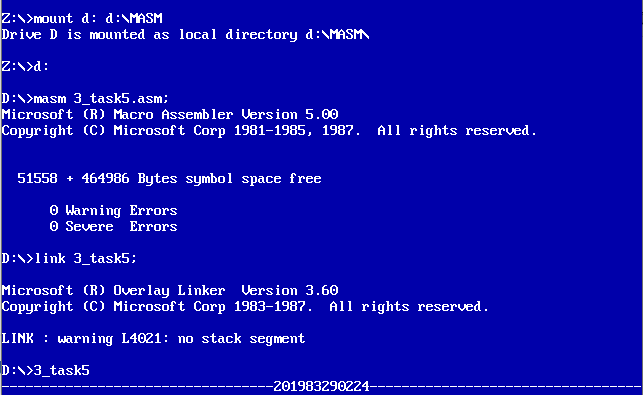1. Experimental task 1
task1.asm source code:
assume cs:code, ds:data data segment x db 1, 9, 3 len1 equ $ - x y dw 1, 9, 3 len2 equ $ - y data ends code segment start: mov ax, data mov ds, ax mov si, offset x mov cx, len1 mov ah, 2 s1:mov dl, [si] or dl, 30h int 21h mov dl, ' ' int 21h inc si loop s1 mov ah, 2 mov dl, 0ah int 21h mov si, offset y mov cx, len2/2 mov ah, 2 s2:mov dx, [si] or dl, 30h int 21h mov dl, ' ' int 21h add si, 2 loop s2 mov ah, 4ch int 21h code ends end start
Operation screenshot:
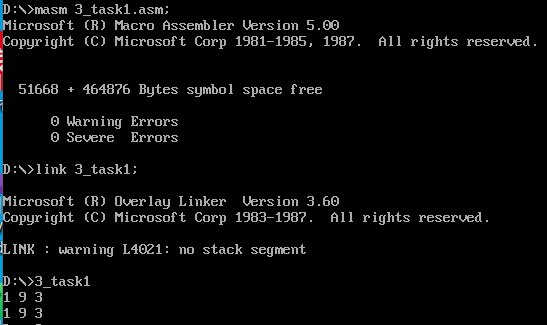
Question 1:
Disassembly screenshot:
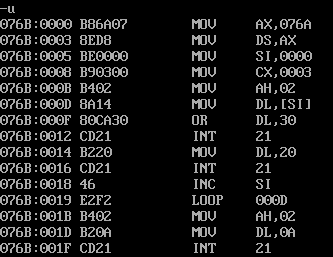
The displacement of jump is - 14. After F2 is converted into the original code, the corresponding decimal value is - 14, so the displacement is - 14. The jump process is as follows: after executing the LOOP 000D command, the IP will automatically add 2 and become 001B, and then jump, 001B+(-E)= 000D, and jump to the place where the IP is 000D.
Question 2:
Disassembly screenshot:
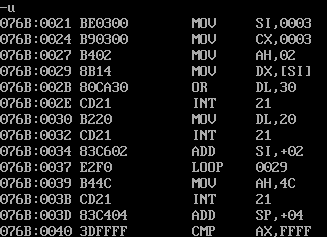
The displacement of jump is - 16. After F0 is converted to the original code, the corresponding decimal value is - 16, so the displacement is - 16. The jump process is as follows: after executing the LOOP 0029 command, the IP will automatically add 2 to 0039, and then jump to 0039 + (- 0010) = 0029, and jump to IP 0029.
Question 3:
Disassembly screenshot above
2. Experimental task 2
task2.asm source code:
assume cs:code, ds:data data segment dw 200h, 0h, 230h, 0h data ends stack segment db 16 dup(0) stack ends code segment start: mov ax, data mov ds, ax mov word ptr ds:[0], offset s1 mov word ptr ds:[2], offset s2 mov ds:[4], cs mov ax, stack mov ss, ax mov sp, 16 call word ptr ds:[0] s1: pop ax call dword ptr ds:[2] s2: pop bx pop cx mov ah, 4ch int 21h code ends end start
(1) Theoretically, ax register stores the offset address of s1, bx register stores the offset address of s2, and cx register stores the segment address of cs. Because when call word ptr ds:[0] is executed, the IP value of the next instruction s1:pop ax will be put on the stack, and then when s1:pop ax is executed, the IP value at the top of the stack will be assigned to ax, which is exactly the offset address of s1. When call dword ptr ds:[2] is executed, the segment address cs of the current code segment and the IP value of the next instruction are successively put on the stack, occupying two bytes each, and then jump to the code executing segment s2, assign the IP at the top of the stack to bx, and then assign the segment address cs to cx, and the IP value is exactly the offset address of s2.
(2) Commissioning verification is as follows:
As can be seen from the figure, the IP value 0021 of call word ptr ds:[0] is assigned to the ax register after s1:pop ax is executed.

It can be seen from the figure that after calling DWORD PTR ds: [2], CS=076C and IP=0026 are put into the stack. After executing s2 segment, BX = 0026 and CX = 076c


The debugging results are consistent with the analysis results.
3. Experimental task 3
task3.asm source code:
assume cs:code, ds:data data segment x db 99, 72, 85, 63, 89, 97, 55 len equ $- x data ends code segment start: mov ax, data mov ds, ax mov cx,len mov si,0 s: mov al,[si] mov ah,0 call printNumber call printSpace inc si loop s mov ah,4ch int 21h printNumber: mov bl,10 div bl mov bx,ax mov dl,bl or dl,30h mov ah,2 int 21h mov dl,bh or dl,30h mov ah,2 int 21h ret printSpace: mov dl,' ' mov ah,2 int 21h ret code ends end start
Put the contents of the data segment into ax one by one and divide by the value of bl to obtain the quotient and remainder. The quotient is in al and the remainder is in ah, which are converted into ASCII code and output respectively.
Screenshot of running test:

4. Experimental task 4
task4.asm source code:
assume cs:code, ds:data data segment str db 'try' len equ $ - str data ends code segment start: mov ax,data mov ds,ax mov si,offset str mov cx,len mov bl,00000010b mov bh,1 call printStr mov si,offset str mov cx,len mov bl,00000100b mov bh,23 call printStr mov ah,4ch int 21h printStr: mov ax,0b800h mov es,ax mov ax,0 mov al,bh mov dx,0a0h mul dx mov di,ax s: mov ah,ds:[si] mov es:[di],ah mov es:[di+1],bl add di,2 inc si loop s ret code ends end start
Screenshot of running test:
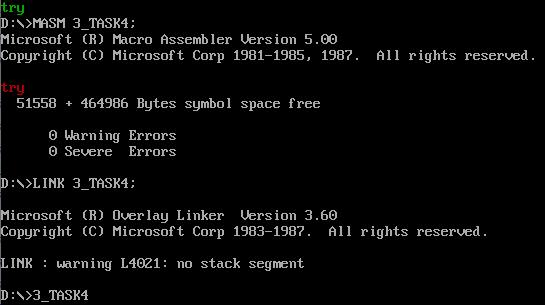
5. Experimental task 5
task5.asm source code:
assume ds:data, cs:code data segment stu_no db '201983290224' len = $ - stu_no data ends code segment start: mov ax,0b800h mov es,ax mov bp,1 mov cx,8000h color: mov byte ptr es:[bp],00011111B add bp,2 loop color mov ax,data mov ds,ax mov ax,0050h sub ax,len mov bh,02h div bh mov bl,al mov bh,0 mov ax,0b800h mov es,ax mov bp,0F00h mov cx,bx s: mov byte ptr es:[bp],'-' add bp,2 loop s mov cx,len mov di,0 s1: mov al,ds:[di] mov es:[bp],al add bp,2 inc di loop s1 mov cx,bx s2: mov byte ptr es:[bp],'-' add bp,2 loop s2 mov ax,4ch int 21h code ends end start
Screenshot of running test:
